 Learning
Objectives for this Unit
Learning
Objectives for this Unit
© Edward Nuhfer
 Learning
Objectives for this Unit
Learning
Objectives for this Unit
The primary reason that most of you are in this course is to meet a Goal 5 requirement at ISU. The most important outcome of this course is not the content about rocks, minerals, maps, or even the unifying theory of plate tectonics. Instead, the most important concept to understand is simply what science is and how it works. Failure to understand these basics has cost the public far more than lack of knowledge about any single geological fact.
Why should I care what science is?
The ability to comprehend the meaning of the term, "science," is tremendously important to any citizen, because the terms "science" and "scientific" are often used to give credibility to statements that range from the purely scientific to the purely manipulative. The most important reason to understand what science is and how science works is that such awareness provides a conceptual framework which allows one to ask for the appropriate evidence and to judge which of two or more competing arguments really is best substantiated by evidence. Consider the following statement:
"...when it (radon) leaks into homes and is inhaled over a long period, it greatly increases the risk of lung cancer." (Coch, 1995, Geohazards p. 307)
A public perception that there is lethal danger from radon will soon result in mandates for disclosure, standards and licensure for inspection and mitigation, restrictions on financing, and possible liability and litigation for sellers. But is the statement a scientific one? What evidence do we have that it really is true? When something is proclaimed as "a hazard," it is important to understand the severity of risks actually posed to life, health, and/or to financial security. Only by starting with an understanding of science and the methods of science can we can evaluate statements like these and decide whether they are well-founded. Then we can use evidence to make choices and decisions for ourselves.
As we approach the 21st century, it is disconcerting to realize how many Americans cannot distinguish between valid science, bogus science, technology, religious belief, occultism, pseudoscience, political statements or mere nonsense. Science illiteracy exists even among highly educated university professors. Philosopher Susan Haack has referred to today's science illiteracy among the educated elite as the "age of preposterism" an age when even university level study is "...characterized by an increasingly widespread and articulate irrationalism." When such confusion exists within even higher education, it is easy to understand why the average citizen is not particularly science-literate.
While you may not consider yourself a scientist, by the end of this course you will probably know far more about the relationships between property and geology than over 95% of the rest of the populace (as frightening as that may now seem!). You can indeed use this information for both yourself and to be helpful to others. The basis for your knowing what information is reliable must ultimately rest in being able to evaluate the degree to which it is based on true science. For this reason we begin with the most important basic question of all.
![]() Learning Objective #1: What is science?
Learning Objective #1: What is science?
We'll use the definition formulated by well-known earth scientist, Arthur Strahler (Figure 1).
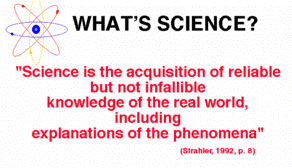
Figure 1. A working definition of science (from Strahler, A. N.,1992, Understanding Science: An Introduction to Concepts and Issues).
Science is not acquisition of just any knowledge. Instead science is limited to knowledge about the "real" or physical world. The "real world" of science involves time, matter and energy, and science seeks to explain phenomena exclusively on the basis of these.
How do we know when scientific knowledge is "reliable?" In science, we test for reliability. You have doubtless heard the term "hypothesis." A hypothesis is simply a testable statement about the real world.
Consider two statements:
The first is a hypothesis; we could test the reliability of it by analyzing table salt in any laboratory. The second is an untestable statement. There is no way to query an inanimate substance about its ethics, and even if we could, ethics is not a topic that can be examined through a study of the physical world.
When you hear any statement that poses as science, you need to make only two queries: (1) "Is this statement or proposition about the physical world?" and (2) "Is the statement testable?" If the answer to both is "yes," then you are likely dealing with a topic that can be resolved by the methods of science.
Let's see how well you can use these criteria to analyze a questionable statement.
Critical Thinking Challenge 1: The following statement from The New York Times writer, Laurie Goodstein, appeared in the Sunday, December 28, 1997, issue of The Denver Post, p. 5A:
"In a startling about-face, the National Association of Biology Teachers, which has long stood firm against religious fundamentalists who insisted that creationism be taught in public schools, recently excised two key words from its platform on teaching evolution.'The diversity of life on Earth,' the group's platform used to read, 'is the outcome of evolution: an unsupervised, impersonal, unpredictable and natural process.'
Now the crucial words 'unsupervised' and 'impersonal' have been dropped. The revision is clearly designed to allow for the possibility that a Master Hand was at the helm."
How does the statement show ignorance of the nature of science, and who involved is displaying the ignorance? Study each word in the statement before you formulate your answer.
For an analysis, link here, but only after you have formulated your answer.
![]() Learning Objective #2: What is meant
by "scientific methodology"
Learning Objective #2: What is meant
by "scientific methodology"
Science discovers knowledge by testing hypotheses, and the methods of science are simply the means by which testing can be done. There are two methods (Figure 2.) Discovery by the method of repeated experimentation was first verbalized by the Austrian philosopher Karl Popper, in The Logic of Scientific Discovery (1939). This soon became taught as THE scientific method, unfortunately. In truth a number of important hypotheses cannot be tested through contrived experiments. For these, we utilize the alternative method of the historical sciences (terminology used by Stephen Jay Gould—hereafter called the historical method). This alternative has also been termed by other workers as the "method of multiple working hypotheses." The two methods of science differ in the ways they gather data and test hypotheses. To see outlines that contrast the methods, click here.
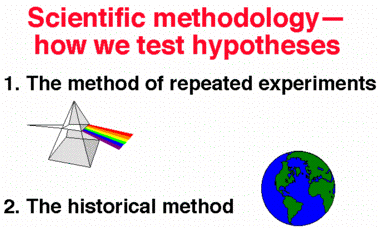
Figure 2. The Methods of Science.
The method of repeated experiments tests hypotheses mainly by constructing experiments and observing whether the results confirm or refute a hypothesis. When workers can independently repeat the same experiment and achieve consistent results, we call the experiment "repeatable" or "reproducible." We consider knowledge discovered through repeatable experiments to have high reliability. For example, the hypothesis: "Common table salt is made of sodium and chlorine," is very amenable to testing by repeated experimentation. After we analyze a sample of salt, then another and another in many different laboratories and come up with the consistent result "that salt is made of sodium and chlorine“ we consider our knowledge about the composition of salt to be very reliable. Figure 3 gives examples of knowledge discovered through the method of repeated experimentation.
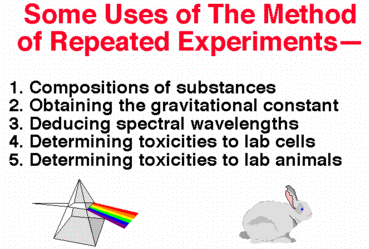
Figure 3. Some examples of knowledge gained by the method of repeated experiments. The experiments are carefully controlled so that the conditions, species of animal, etc. can be reconstructed in another experiment to assure reproducibility. This is the method most commonly used to advance knowledge in chemistry and physics.
Hypotheses are not always testable through the methods of repeated experimentation. Consider: "Continents have moved great distances over long periods of time on planet Earth" or "Massive extinctions of life have occurred several times during our Earth's history."
We can't put a continent into a laboratory dish to study if it moves or what makes it move, and we cannot do experiments that wreak wholesale damage in order to understand mass extinctions. Even if we could, the question always arises about whether our experimental conditions produce outcomes that differ from outcomes under the actual conditions. Nevertheless, the above statements are true hypotheses and they are testable, but they are better tested through the historical method than the experimental method. Instead of gathering data by doing controlled experiments, the historical method gathers its data directly from the real world. In geology, such data comes mostly from field work. The data constantly grows as researchers do more work, and we can use this data as a means to test several competing hypotheses at once in order to reveal which one best explains our current base of knowledge. It is more difficult to achieve reliable knowledge through the historical method because we are working in a complex environment rather than with a controlled experiment. Reliable knowledge may come only after many workers through many years have produced a data base sufficient to distinguish the strongest hypothesis. Development of the plate tectonics theory took centuries and contributions by thousands of workers. Yet today, the reality of plate tectonics appears as solid as the reality of atoms and molecules.
A good hypothesis is often tested against its converse. For instance, "Massive extinctions of life have occurred several times during our Earth's history" has a converse, "Massive extinctions of life have not occurred several times during our Earth's history." When our knowledge base of past life was very small and primitive, we couldn't really tell which hypothesis was better. However, as numerous workers obtained more detailed knowledge of fossils through over two centuries of work, we could see from the accumulated record that many organisms existed for long periods and abruptly disappeared at about the same time, never to return. After we had done enough work to realize that this pattern repeated several times in the rock record, this knowledge gave our first hypothesis far greater credibility. This led us to look carefully at the rocks deposited in these times of disappearances to discover mechanisms that may have caused extinctions. When we found evidence of mechanisms (massive meteorite impacts occurring at these times), we had an even more solid basis to support the first hypothesis and to refute second. Figure 4 gives examples of knowledge produced through the historical method.
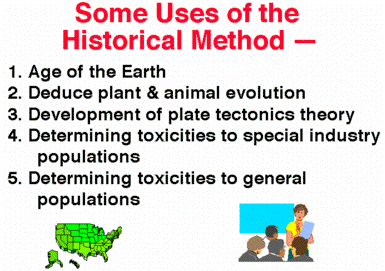
Figure 4. Some examples of knowledge gained by the historical method. The historical method is more developed in geology than in any other science, but geology, biology and environmental science use both the historical and experimental methods.
Science is not infallible, and good scientific investigations can still yield incorrect results. Several years ago two researchers claimed to have produced energy in the laboratory through a process called "cold fusion." This was an exciting event because the results implied a limitless source of cheap, clean energy for mankind. Unfortunately, other researchers could not reproduce the claimed results, and soon the original researchers found that they could not produce energy by this method either. As more experiments were repeated, it became apparent that the hypothesis, "Cold fusion can generate large amounts of energy," was unsupportable and thus fallible. What went wrong? Perhaps something had gone wrong with the laboratory equipment or measurements to cause the original experiment to be misinterpreted., or perhaps the investigators themselves wanted so much to believe they had succeeded that their subjective emotions overcame their scientific judgement. Despite the fact that an embarrassing mistake had occurred, the method of repeated experimentation eventually deduced the error.
William Thomson (Lord Kelvin), estimated the age of the earth in 1897 at 98 million years (Wood, 1985, p. 27). To reach this age, Kelvin assumed Earth was once at about the red-hot temperature of lava we see today in volcanoes. He had devised equations to calculate the length of time that it took to cool objects of known mass, size and shape from one temperature to another. Knowledge was sufficient in his time to allow him to know the mass, size and shape of Earth, so he arrived at his age by calculating the time it would take to cool the planet from red-hot to what he believed to be the present temperature. Kelvin used testable knowledge to arrive at his age estimate. Anyone could test Kelvin's mathematical logic by cooling spheres of known mass and size from one temperature to another. By using the mass and size of the Earth and any reasonable assumption for an original temperature, all workers would arrive at some age that would be generally compatible with Kelvin's. While Kelvin's experiments were repeatable, the estimate for the age of the Earth seemed too young to account for what geologists were seeing in the field. Thus we had discord between a laboratory experiment and the field data generated by the historical method. Later, scientists recognized that the age of the Earth cannot be reached by calculating a time span for cooling because the planet is simultaneously being heated from within. Kelvin couldn't know this; the required knowledge came later, after radioactivity was discovered in the early 1900s. Soon radioactivity became recognized as a source of heat production within the Earth. About fifty years later, scientists learned to use radioactivity as a better means for dating the Earth. The current age of Earth, 4.6 billion years, seems to be the most reliable of all estimates because it is reproducible, and it far better fits the field data that is currently available than any prior age estimate.
As seen from both examples, the body of knowledge accrued by science is characterized by continuous improvement rather than by instant attainment of complete "truth."
![]() Learning Objective #3: What is meant
by "extrapolating scientific knowledge?"
Learning Objective #3: What is meant
by "extrapolating scientific knowledge?"
Extrapolation is an important concept to understand when Real Estate topics like radon and asbestos are considered. When we take data from experiments or field studies and then try to use it to make conclusions about another situation, we say that we are "extrapolating scientific knowledge." Extrapolation usually can be stated in a form that approximates "this means that...." For example, Kelvin did an extrapolation from the rate that cannon balls cooled in a laboratory by saying that the data could be used to estimate the age of the Earth. In essence he was saying that based on the lab data, this means that the Earth is about 98 million years old. We saw from Kelvin's example that taking laboratory results and extrapolating them to another situation can be risky. Extrapolations don't confirm or test hypotheses, but they generate their own untested hypotheses. See Figure 5.
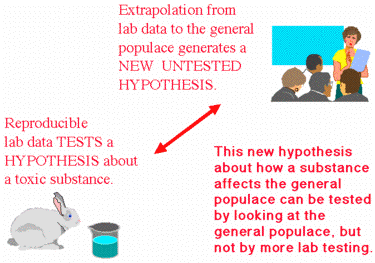
Figure 5. The relationship between experimental results and what they may or may not mean about the real world. We can do excellent science in the laboratory that gives highly reliable knowledge. We may then (see double ended arrow) extrapolate this laboratory data to estimate what the effects on a general populace of humans may be. "Risk analysis" is simply a mathematical way of expressing the estimate. Such estimates merely express hypotheses; they are not confirmations of hypotheses.
Critical Thinking Challenge 2. Look at the situation depicted in Figure 5a. Decide which methods of science have been used and what hypothesis(es) have been tested. Identify the extrapolation, if one is present. Decide if the statement made about homeowners and office workers is a proven fact or a hypothesis. If it is a hypothesis, is it testable, and how might we test it? Spend at least five minutes thinking about this and writing your answer BEFORE you click on the discussion.
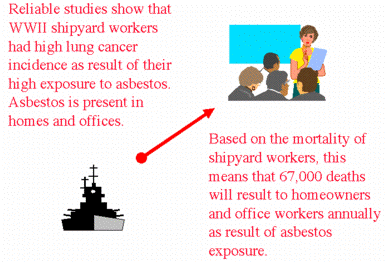
Figure 5a. Extrapolation or proven hypothesis? Click here for discussion.
At this point, we have covered enough of the basic concepts of science to allow us to use this as a solid foundation for the content which follows. You are free to go further in this lesson if you wish.
| Optional Section: for a deeper perspective on science, click here. |
 Printed References
Printed References
Haack, S., 1998, Manifesto of a Passionate Moderate: University of Chicago Press, Chapter 5, "Puzzling out Science," pp. 90-103. This chapter, and the following, "Science as Social? Yes and No," provide insights into how " post-modern " education sometimes misrepresents the true nature of science and in doing so promotes science illiteracy. The book is entertaining and enlightening, and is written by a philosophy professor for a well educated audience. It is best read by laypersons with a dictionary nearby.
Padian, K., 1993, Improving science teaching: the textbook problem : Skeptical Inquirer, v. 17, n. 7, pp. 388-393. Illustrates the problems created by the "dumbing down" of science education by writers and publishers of textbooks. The Skeptical Inquirer is a particularly good magazine for debunking contemporary superstition and pseudoscience.
Strahler, A. N.,1992, Understanding Science: An Introduction to Concepts and Issues: Buffalo, NY, Prometheus Books, 423 p. A book mostly for the serious scholar and particularly useful for earth scientists.
Wolpert, L.,1992, The Unnatural Nature of Science: Cambridge, MA, Harvard University Press, 191 p. This is a superb and very readable book on the development and nature of the discipline that we now call "science."
 Videotape
Videotape
What is Science?, (20 Minutes), Hawkhill Associates, 125 East Gilman St., Madison, WI 53703. Telephone: 1-800-422-4295, email: hawkhill@Home.com. An exploration of scientific methods and values today. A program "highly recommended" by Hans O. Anderson, past president of the National Science Teachers Association.
 Resources on the Internet
Resources on the Internet
Bad Science http://www.ems.psu.edu/~fraser/BadScience.html This page is maintained by Alistair B. Fraser in an attempt to sensitize teachers and students to examples of the bad science often taught in schools, universities, and offered in popular articles and even textbooks.
Committee for the Scientific Investigation of Claims of the Paranormal (CSCIOP)- CSCIOP is dedicated to promoting an understanding of true science as distinguished from pseudoscience and junk science. The magazine, "Skeptical Inquirer" is produced by this same group. Overall the CSCIOP group provides excellent and stimulating reading material on important issues. http://www.csicop.org
Junkscience.com Steve Milloy’s site at http://www.junkscience.com/ has a controversial slant, but it is worth visiting. Some very good examples of how data is manipulated to obtain conclusions that are based on an agenda rather than objective interpretation are presented here. However, the obvious agenda at this site sometimes overrides solid reporting.
Public television series, NOVA, offers online resources relating to its collection of popular science episodes: http://www.pbs.org/wgbh/nova/
Smithsonian Natural History Web is an internet resource compiled and maintained by the staff of the National Museum of Natural History: Here you'll find documents and data about Museum research and the national collections, which comprise more than 120 million scientific specimens and cultural artifacts from around the world. http://www.nmnh.si.edu
What is Science? A very readable page with links created by geology professor Dr. Bruce Railsback of the University of Georgia. http://www.gly.uga.edu/railsback/railsback_1122science1.html